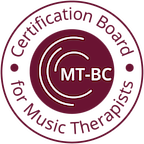Today we are going to take a deeper look at a Neurological Music Therapy technique!
Theraputic Instrumental Music Performance (TIMP): This is a technique that I use with nearly all my clients with sensorimotor goals. TIMP is defined as playing musical instruments to…
exercise and stimulate functional movement patterns. Appropriate musical instruments are selected in a therapeutically meaningful way in order to emphasize range of motion, endurance, strength, functional hand movements, finger dexterity, and limb coordination (Elliot 1982, Clark and Chadwick, 1980). During TIMP, instruments are not typically played in the traditional manner, but are placed in different location to facilitate practice of the desired functional movements. (Thaut 2005).
Within the experience of this technique, the client is an active member of the music-making process. The music therapist will establish an appropriate music experience for the client to participate in with success.
Session example:
Goal: finger isolation
Therapeutic Music Experience (TME): TIMP Therapist has child at the piano, place five fingers across the keys, and have client play color-coded notes (engaging target fingers) along to their favorite song.
If you would like to learn more about how TIMP and other music therapy interventions could benefit your child, please schedule a free 20-minute consultation with me!
Continue reading if you would like to know more about Neurological Music Therapy practice…
What is Neurological Music Therapy (NMT)?
Neurological Music Therapy is defined as the therapeutic application of music to cognitive, sensory, and motor dysfunctions due to neurologic disease of the human nervous system. NMT is based on a neuroscience model of music perception and production, and the influence of music on functional changes in nonmusical brain and behavior function. (Thaut, 2005)
Is there standardization of the practice of NMT?
NMT Techniques are evidence-based: They are based on data from scientific and clinical research and are directed toward functional nonmusical therapeutic goals. NMT treatment techniques are standardized in terminology and application and are applied to therapy as therapeutic music interventions that are adaptable to the patient’s functional needs. There are currently 20 standardized NMT interventions. The clinical application of these interventions is subdivided into three treatment domains: a) sensorimotor training, b) speech and language training, c) cognition training. Therapeutic treatment is directed toward functional rehabilitative, developmental, or adaptive goals. Because the system of techniques is research-based, it is dynamically open-ended in terms of future development and knowledge. Researchers and clinicians work together on an ongoing basis to collect data on treatment success rates and to provide direction for further research and development of standardized interventions. (Thaut, 2005)
What type of assessment procedure is utilized to determine treatment goals and interventions?
Assessment is an essential component for implementing best practice standards. NMT assessment can occur in a meaningful way because standardization has been achieved and outcome data is available on an increasing level. The NMT practitioner follows a Transformational Design Model for clinical practice that provides a system for determining functional therapeutic goals and objectives and allows for translation of nonmusical therapeutic exercises into functional therapeutic music experiences that result in real-world application of skills. (Thaut, 2005)
Resources
- Thaut, M. (2013). Rhythm, Music, and the Brain. Music, Rhythm, and the Brain. https://doi.org/10.4324/9780203958827



